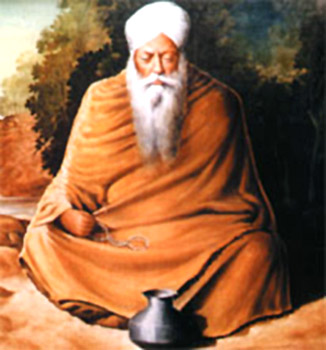 Puran Singh (1881-1931) was a Punjabi writer of the Singh Sabha who was greatly influenced by Bhai Vir Singh. Puran Singh broke all traditional barriers and chose free verse for his poetic compositions, following the style of the American poet Walt Whitman. He wrote three volumes of Punjabi poetry, Khule Maidan (Free Meadows, 1923), Khule Ghund (Free Veils, 1923), and Khule Asmani Rang (Boundless Blue Colors of the Sky, 1926). His poetry is characterized in letter and spirit by the tendency to go above and beyond the limits of self, home, and country. There is a certain mood of abandon that permeates his whole verse.
Puran Singh (1881-1931) was a Punjabi writer of the Singh Sabha who was greatly influenced by Bhai Vir Singh. Puran Singh broke all traditional barriers and chose free verse for his poetic compositions, following the style of the American poet Walt Whitman. He wrote three volumes of Punjabi poetry, Khule Maidan (Free Meadows, 1923), Khule Ghund (Free Veils, 1923), and Khule Asmani Rang (Boundless Blue Colors of the Sky, 1926). His poetry is characterized in letter and spirit by the tendency to go above and beyond the limits of self, home, and country. There is a certain mood of abandon that permeates his whole verse.
The most important feature of his verse is its passionate preaching of the importance of common people. The hardworking and patient farmers of Punjab and the passionate heroes and heroines of love stories have been portrayed with such a sincere sentiment that they gain a special significance in the world of the poet. They become symbols of universal love and freedom. He talks about the poor and the hungry and idealizes them, seeing in their eyes a peace and contentment that he misses in the vulgar rich. In some of his poems, he has reinterpreted the medieval romances of Hir Ranjha, Sohni Mahival, Sassi Punnu and Puran Bhagat and made them the true representatives of the free human spirit. He sings the praises of the rather less known humble trees of the land and sees untold beauty in obscure flowers. He draws the poetic sketch of a poor village woman who is making cow-dung cakes and tries to project her as a kind of great artist. He creates scenes from everyday life of Punjab and portrays some immortal Punjabi characters. He sings in praise of Sikh gurus, particularly focusing on the 10th master, Guru Gobind Singh, whose philosophy had struck him as being profound and majestic.
Puran Singh strove to live a universal religion that went beyond the barriers of various established faiths, even though was saturated with an intense feeling of the life and teachings of the Sikh gurus. In one of his poems, he calls on God not so he may worship him, but with an appeal that he may break all instruments of worship with his own hands so that people can be free from the shackles of man-made religions.
In Puran Singh, Punjabi literature took a firm step forward toward modernity. Whereas Puran Singh liberated Punjabi poetry from the limits of religious preaching and didacticism and made his verse intense, uncontrolled emotion, he also, for the first time, focused his attention on the common people and identified his sympathies with common people of Punjab. New Punjabi poetry follows Puran Singh in recognizing the down-to-earth problems of the common masses. His rejection of the idea of an organized religion and promotion of democratic and egalitarian self-reliance also gave strength to the progressive poetry written under the Marxist creed of writing.



















